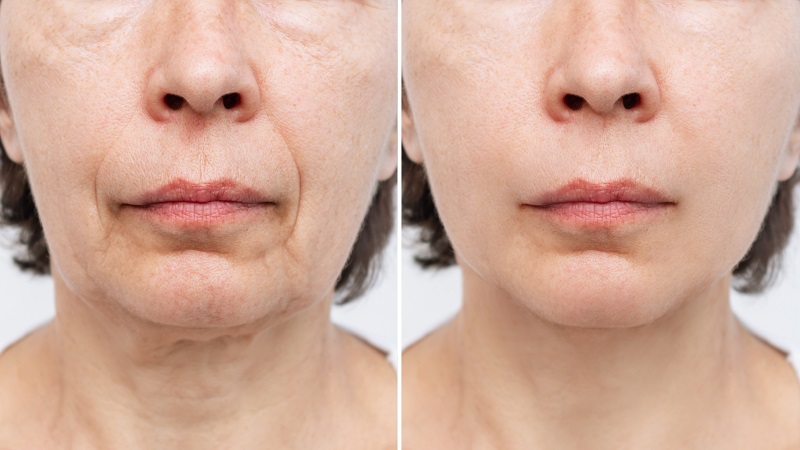The cosmetic industry offers many solutions for “turning back the clock” on aging. People who aim for a youthful look, tight, plump, and supple skin can choose between surgical and non-surgical treatments, depending on their desired results. Those looking for a dramatic reversal of aging signs opt for plastic surgery called rhytidectomy, popularly known as a facelift.
This article explains how a facelift works, who can and cannot have the procedure, how to prepare for it, and what results to expect.

What Is Facelift?
A facelift or rhytidectomy is a surgical procedure that restores youthful contours in the lower two-thirds of the face and tightens sagging skin in the upper neck. It addresses the following aging signs:
- Sagging skin in the cheeks and the jaw (jowls).
- Deep folds between the nose and the corners of the mouth (nasolabial folds).
- Loose skin and excess fat in the neck.
The surgery involves making incisions along the sides of the face, in the hairline, and under the chin to remove or reposition excess skin, remove excess fat, and tighten the underlying tissue and muscles.
Note: Learn how dermal fillers for nasolabial folds work, and what can you expect from the procedure.
Types of Facelifts
The facelift has many variations, depending on the patient’s bone structure, skin quality, amount of excess skin, and desired goals. Common facelift types include:
Traditional Facelift
The traditional or standard facelift involves the manipulation of the SMAS (superficial musculoaponeurotic system) that lies just below subcutaneous fat on the lower face and neck. For this reason, the traditional facelift is sometimes called the SMAS technique.
The plastic surgeon makes incisions that start at the temples behind the hairline, continue down and around the front of the ears, and end in the lower scalp. It may also include an incision under the chin. Then they remove excess skin in the mid-face area and jowls, reposition the deeper tissues beneath the skin, tighten the muscles, and contour the neck.
Mini-Facelift
This procedure is suitable for patients with only a little loose skin and early signs of jowls and sagging skin.
The plastic surgeon makes smaller incisions which begin in the hairline above the ears and finish in the natural creases surrounding the ears. They don’t extend into the lower scalp.
Mini-facelifts provide structural changes in the mid-face area, lifting the cheeks and contouring the jawline.
Note: Find out how can cheek fillers help you lift the cheeks, and what jawline contouring treatments are there.
Deep Plane Facelift
Deep plane facelifts are more invasive than traditional facelifts, targeting deeper tissues and muscles. They suit people with more pronounced aging signs and provide more long-lasting results than other facelifts.
Plastic surgeons lift the skin, the SMAS layer, and fat as a single unit rather than separately, as in the standard facelift. The surgery repositions fat pads in the cheek, restoring volume and lifting the mid-face area.
Necklift
A necklift tightens sagging jowls and loose neck skin, eliminating the double chin. The plastic surgeon makes incisions in front of the earlobe, behind the ears, in the lower scalp, and under the chin.
Note: Learn how neck Botox helps lift and rejuvenate the neck.
Non-surgical Facelift
Patients who don’t want to go under the knife can enjoy comparable results with a 10-point facelift – a non-invasive treatment involving strategic dermal filler placement throughout the face for a dramatic rejuvenation effect.
Fillers replace lost fatty volume in the cheeks, temples, lips, under-eyes, nasolabial folds, and chin, targeting more areas than surgical facelifts, but with shorter results (up to two years).
What Areas Can Be Treated?
Most people know what facelifts are, but few understand that the procedure only involves tightening and lifting the lower two-thirds of the face and neck. The procedure targets lost fatty volume and relaxed skin in the following areas:
- Cheeks
- Nasolabial folds
- Jaw
- Chin
- Neck
The procedure doesn’t address sunken eyes, drooping eyelids, wrinkles, and pigmentation issues. Patients who want to correct these imperfections can combine the facelift with other surgical or non-surgical procedures, such as the brow lift, eyelid lift, Botox, laser resurfacing, etc.
Who Is a Good Candidate for a Facelift?
During the consultation, your plastic surgeon will determine if you meet the requirements for the surgery. Candidates for the procedure generally include:
- Healthy adults without any medical issues related to blood clotting and healing.
- Non-smokers.
- Mentally healthy individuals who understand what the procedure can and cannot do.
What Is the Best Age to Have a Facelift?
Facelift candidates are typically between 40 and 60 years old, at an age when sagging skin and hollowness in the mid-face region become prominent. Some people opt for mini facelifts earlier in life (e.g., in their 30s) to delay premature aging signs or correct minor mid-face and neck concerns.
How to Prepare for a Facelift Treatment?
During the consultation, the plastic surgeon explains to patients what to do before the facelift procedure. They typically advise patients to:
- Avoid medications that increase bleeding, such as aspirin, ibuprofen, some herbal supplements, etc.
- Discontinue or adjust current medications.
- Stop smoking and using recreational drugs.
- Wash their face and hair with germicidal soap before the surgery.
- Avoid eating 8 hours before the surgery.
Patients need to arrange transportation home after the facelift and, ideally, someone to look after them during the first 24-48 hours.
What to Expect During a Facelift Procedure?
A facelift requires the administration of local or general anesthesia.
After the medication takes effect, the plastic surgeon makes incisions in the patient’s hairline, down the sides of the face, behind the ears, in the lower scalp, and under the chin.
They separate the skin from the underlying connective tissue and muscles, tighten the muscles and supporting structures, remove fat and excess skin, and redrape the remaining facial skin.
The surgeon closes the incisions with absorbable sutures, removable stitches, or skin glue, and the recovery process begins.
Facelift Results

The facelift doesn’t alter one’s fundamental appearance. However, it dramatically tightens and firms the skin, eliminating sagging jowls, contouring the jawline and chin, and rejuvenating the face and neck.
The first results of facelift surgery are visible after the bruising and swelling subside, usually within 14 days after the procedure. It takes two or three months for the skin to heal fully.
The results typically last seven to ten years. The results can last more than ten years with more invasive surgery, such as the deep plane facelift. Patients can also prolong the results with simple lifestyle habits, such as:
- Using sunscreen
- Getting enough sleep
- Eating nutritionally rich food
- Maintaining stable weight
- Drinking plenty of water
Sometimes, patients don’t achieve desired results and require another treatment. This happens more frequently to patients with a history of weight fluctuations because repeated weight loss and gain affect skin elasticity and the shape of the face.
Facelift Side Effects
Bruising and swelling are common facelift side effects.
Like all surgical procedures, facelifts carry a small risk of infection, bleeding, reaction to anesthesia, and hematoma.
Other rare complications and side effects include:
- Facial nerve injury
- Cardiac and pulmonary complications
- Numbness and skin sensitivity
- Pain
- Skin loss
- Hair loss
- Skin discoloration
- Scarring
- Asymmetrical features
When Should You See a Doctor?
Visit your surgeon or medical provider immediately if you experience the following severe symptoms after a facelift:
- Excessive bleeding
- Prolonged and extreme swelling
- Extreme pain
- Fever
- Pus at the incisions
Facelift Recovery
Facelift patients wear bandages the first couple of days after a facelift. Some may require surgical drainage tubes to remove excess blood and fluid from the incisions. After one week, the plastic surgeon removes the stitches, or they dissolve on their own.
Patients who have a mini facelift can go back to work after five to seven days. Patients who undergo a more invasive facelift usually return to work after two to three weeks.
Plastic surgeons have general guidelines for patients to help them improve and speed up the healing process during the first weeks. The recommendations include:
- Follow the doctor’s instructions on how to handle the bandages and drains.
- Elevate your head during rest.
- Apply cool packs to reduce pain and swelling.
- Don’t pick at the crusts that form on the wounds.
- Don’t apply pressure on or near the incision sites.
- Avoid vigorous physical activity.
- Follow the doctor’s recommendations for skincare products and shampoo use.
- Don’t apply makeup.
- Avoid direct sunlight.
- Avoid clothes that are pulled over the head.
Most patients return to normal activities after two or three weeks.
How Much Is a Facelift?
According to the American Society of Plastic Surgeons, the average cost of a facelift surgery is $8,000. However, the price doesn’t include anesthesia fees, surgical facility costs, post-surgery medications, bandages, drain tubes, and other related expenses.
The final cost depends on the type of facelift, the patient’s recovery period, and what additional care they need during the process.
Health insurance plans usually don’t cover the cost of a facelift surgery because it is a cosmetic procedure.
At Vibrant Skin Bar, we offer a non-surgical dermal filler facial support treatment, “10-Point Facelift,” for only $2,999. This aesthetic injectable treatment can support sagging skin, smooth fine lines, and replace lost volume.
Conclusion
The facelift is a popular cosmetic surgery that reverses the effects of aging and provides dramatic rejuvenation results that can last a decade.
The procedure involves a higher likelihood of complications than non-surgical treatments. If you want to avoid this risk, contact the Vibrant Skin Bar team to help you look as young as you feel with the non-invasive 10-Point Facelift.




